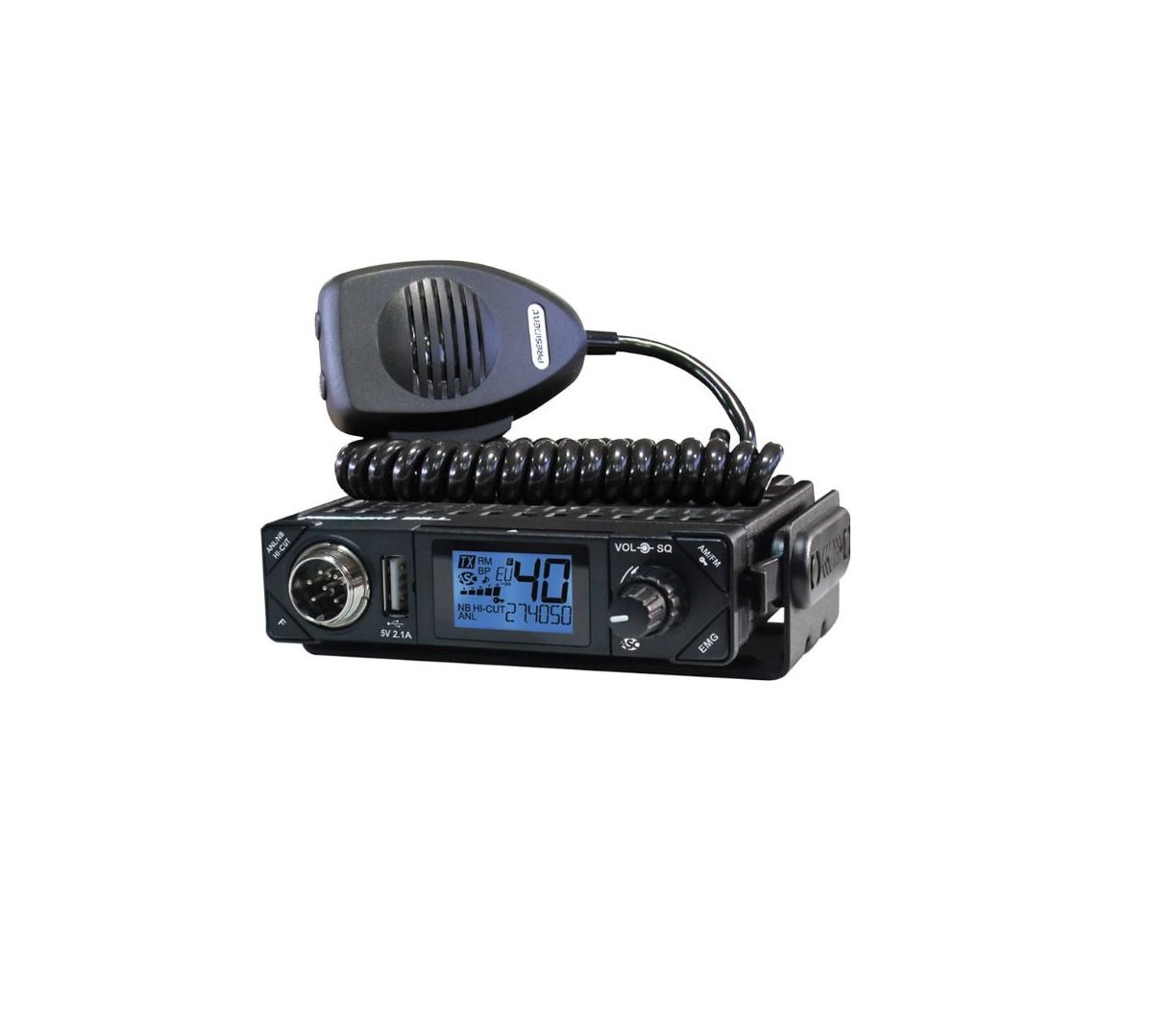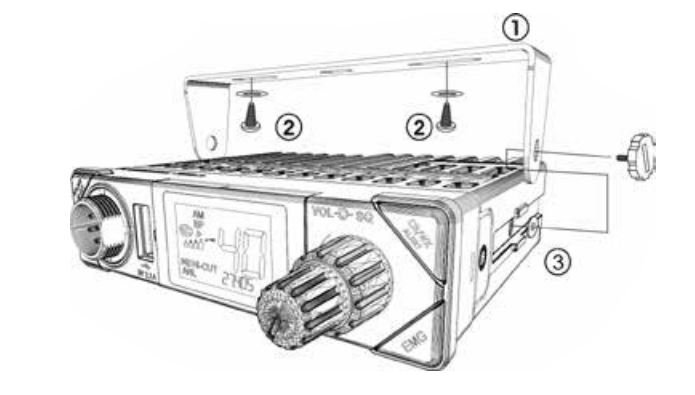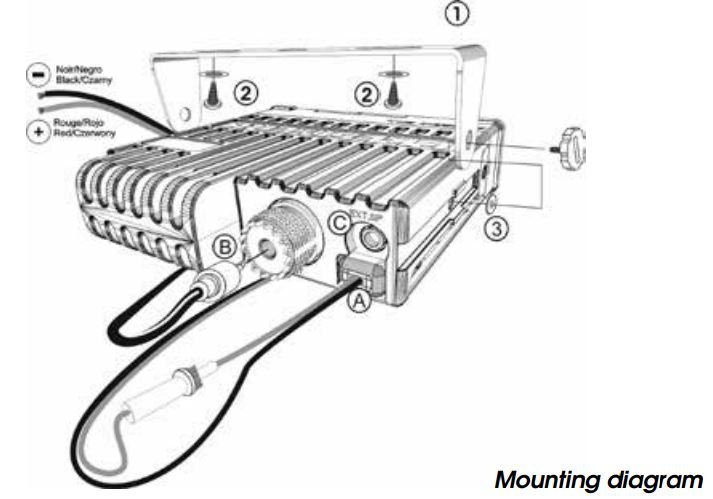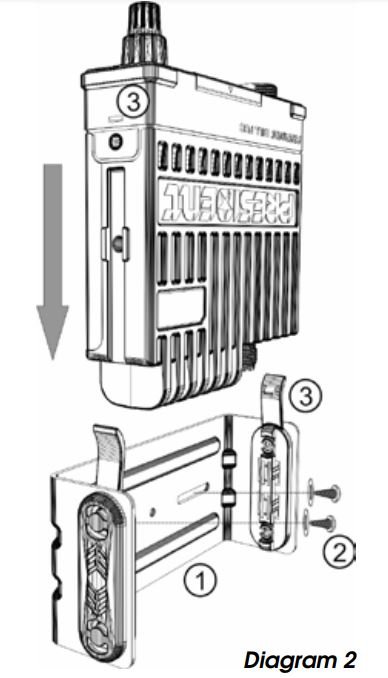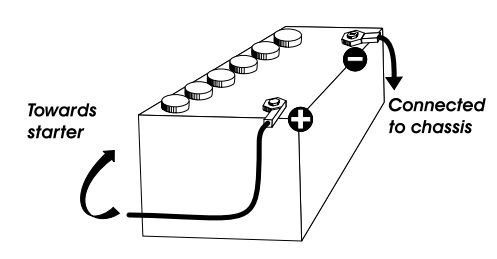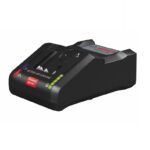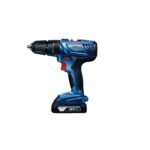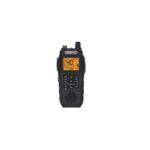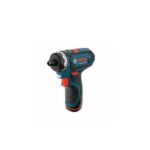President TXUS001 BILL FCC ASC User Manual
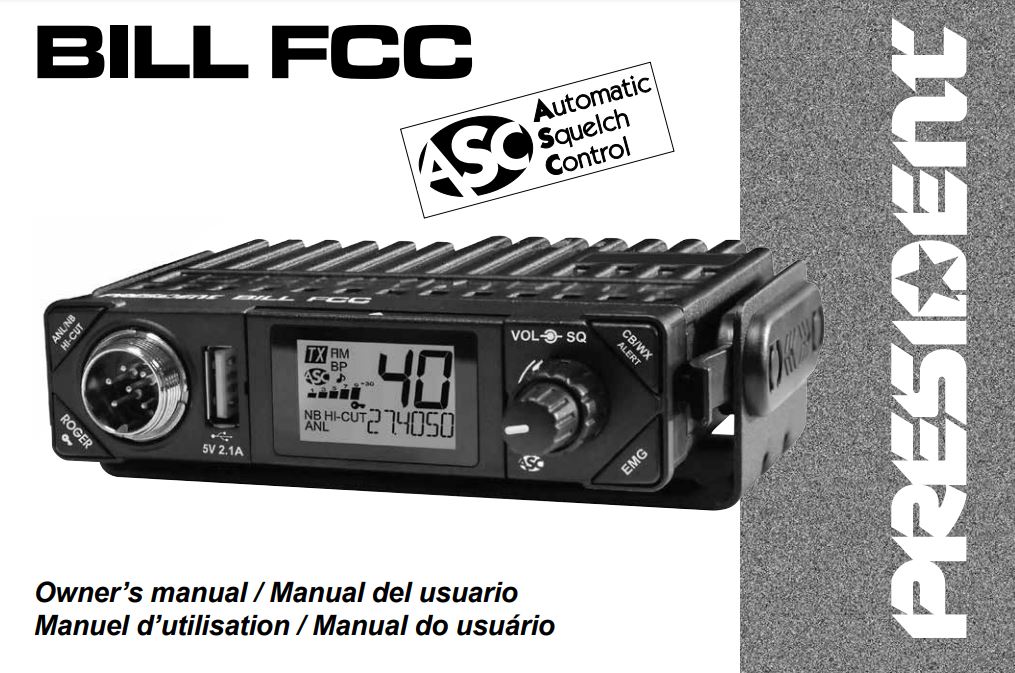
Your PRESIDENT BILL FCC at a glance Un vistazo a vuestro PRESIDENT BILL FCC
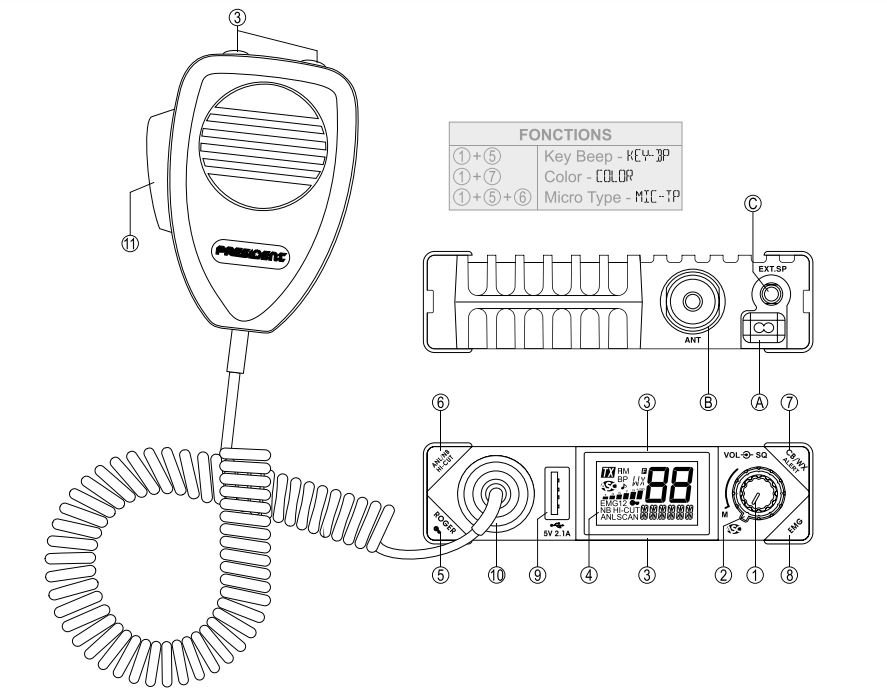
⚠️WARNING: This product can expose you to chemicals including Lead, which is known to the State of California to cause cancer and birth defects or other reproductive harm. For more information go to www.P65Warnings.ca.gov.
AVERTISSEMENT : Ce produit peut vous exposer à des agents chimiques, y compris le plomb, identifiés par l’État de Californie comme pouvant causer le cancer et des malformations congénitales ou autres effets nocifs sur la reproduction. Pour de plus amples informations, prière de consulter le site www.P65Warnings.ca.gov.
WARNING ! Before using, be careful never to transmit without first having connected the antenna (connection “B” situated on the back panel of the equipment) or without having set the SWR (Standing Wave Ratio) ! Failure to do so may result in destruction of the power amplifier, which is not covered by the guarantee. |
The guarantee of this transceiver is valid only in the country of purchase.
Welcome to the world of the new generation of CB radios. The new PRESIDENT range gives you access to top performance CB equipment. With the use of up-to-date technology, which guarantees unprecedented quality, your PRESIDENT BILL FCC is a new step in personal communication and is the surest choice for the most demanding of professional CB radio users. To ensure that you make the most of all its capacities, we advise you to read carefully this manual before installing and using your PRESIDENT BILL FCC.
INSTALLATION
1) WHERE AND HOW TO MOUNT YOUR MOBILE CB RADIO
- You should choose the most appropriate setting from a simple and practical point of view.
- Your CB radio should not interfere with the driver or the passengers. Diagram 1


- Remember to provide for the passing and protection of different wires (e.g. power, antenna, accessory cabling) so that they do not in any way interfere with the driving of the vehicle.
Mounting with the cradle (diagram 1) - To install your equipment, use the cradle (1) and the self-tapping screws [2] provided (drilling diameter 3.2 mm). Take care not to damage the vehicle’s electrical system while drilling the dash board.
- Do not forget to insert the rubber joints (3) between the CB and its support as these have a shock-absorbing effect which permits gentle orientation and tightening of the set.
- Choose where to place the microphone support and remember that the microphone cord must stretch to the Diagram 1 driver without interfering with the controls of the vehicle.
- To install your equipment, use the quick fixation clip (1) and the self-tapping screws [2] provided (drilling diameter 3.2 mm). Take care not to damage the vehicle’s electrical system while drilling the dash board.
- Choose where to place the microphone support and remember that the microphone cord must stretch to the driver without interfering with the controls of the vehicle.
- Slide the unit into the slide of the support and fix it by clipping the side tabs into the notches of the CB (3).

– Note: As the transceiver has a frontal microphone socket, it can be set into the dash board. In this case, you will need to add an external loud speaker to improve the sound quality of communications (connector EXT.SP situated on the back panel: C). Ask your dealer for advice on mounting your CB radio.
2) ANTENNA INSTALLATION
a) Choosing your antenna
– For CB radios, the longer the antenna, the better its results. Your dealer will be able to help you with your choice of antenna.
b) Mobile antenna
– Must be fixed to the vehicle where there is a maximum of metallic surface (ground plane), away from windscreen mountings.
– If you already have a radio-telephone antenna installed, the CB antenna should be higher than this.
– There are two types of antenna: pre-regulated which should be used on a good ground plane (e.g. car roof or lid of the boot), and adjustable which offer a much larger range and can be used on a smaller ground plane (see § ADJUSTMENT OF SWR page 7).
– For an antenna which must be fixed by drilling, you will need a good contact between the antenna and the ground plane. To obtain this, you should lightly scratch the surface where the screw and tightening star are to be placed.
– Be careful not to pinch or flatten the coaxial cable (as this runs the risk of break down and/or short-circuiting).
– Connect the antenna (B).
c) Fixed antenna
Output radius pattern
– A fixed antenna should be installed in a clear space as possible. If it is fixed to a mast, it will perhaps be necessary to stay it, according to the laws in force (you should seek professional advice). All PRESIDENT antennas and accessories are designed to give maximum efficiency to each CB radio within the range.
3) POWER CONNECTION
Your PRESIDENT BILL FCC is protected against an inversion of polarities. However, before switching it on, you are advised to check all the connections. Your equipment must be supplied with a continued current of 12 volts (A).
Today, most cars and trucks are negative ground. You can check this by making sure that the negative terminal (-) of the battery is connected either to the engine block or to the chassis. If this is not the case, you should consult your dealer.
WARNING: Trucks generally have two batteries and an electrical installation of 24 volts, in which case it will be necessary to insert a 24/12 volt converter (type CV 24/12 PRESIDENT) into the electrical circuit. The following connection steps should be carried out with the power cable disconnected from the set.
- Check that the battery is of 12 volts.
- Locate the positive and negative terminals of the battery (+ is red and – is black). Should it be necessary to lengthen the power cable, you should use the same or a superior type of cable.
- It is necessary to connect your CB to a permanent (+) and (-). We advise you to connect the power cable directly to the battery (as the connection of the CB cable to the wiring of the car-radio or other parts of the electrical circuit may, in some cases, increase the likelihood of interference).
- Connect the red wire (+) to the positive terminal of the battery and the black (-) wire to the negative terminal of the battery.
- Connect the power cable to your CB radio.

WARNING: Never replace the original fuse by one of a different value.
4) BASIC OPERATIONS TO BE CARRIED OUT BEFORE USING YOUR SET FOR THE FIRST TIME (without transmitting and without using the «push-to-talk» switch on the microphone)
- Connect the microphone,
- Check the antenna connections,
- Turn the set on by turning the volume knob VOL (1) clockwise,
- Turn the squelch SQ knob (2) to minimum (M position),
- Adjust the volume to a comfortable level,
- Go to channel 20 using either 🔼/🔽 keys (3) on the unit or the UP/DN keys (3) on the microphone.
5) ADJUSTMENT OF SWR (Standing wave ratio)
WARNING: This must be carried out when you use your CB radio for the first time (and whenever you re-position your antenna). The adjustment must be carried out in an obstacle-free area.
* Adjustment with external SWR-meter (e.g. TOS-1 PRESIDENT)
- To connect the SWR meter
– Connect the SWR meter between the CB radio and the antenna as close as possible to the CB (use a maximum of 15.75” / 40 cm cable, type President CA-2C). - To adjust the SWR meter
– Set the CB on channel 20.
– Put the switch on the SWR-meter to position FWD (calibration).
– Press the «push-to-talk» switch on the microphone (11) to transmit.
– Bring the index needle to 🔽 by using the calibration key.
– Change the switch to position REF (reading of the SWR level). The reading on the Meter should be as near as possible to 1. If this is not the case, re-adjust your antenna to obtain a reading as close as possible to 1. (An SWR reading between 1 and 1.8 is acceptable).
– It will be necessary to re-calibrate the SWR meter after each adjustment of the antenna.
WARNING: In order to avoid any losses and attenuations in cables used for connection between the radio and its accessories, PRESIDENT recommends to use a cable with a length less than 118.11” / 3 m. Your CB is now ready for use.
HOW TO USE YOUR CB
1) ON/OFF – VOLUME
- To turn the set on, turn the VOL knob (1) clockwise. If the KEY BEEP function is activated, 4 tones sound when you turn the CB radio on.
Note: On power up, in order to inform the user, the programmed microphone type is displayed for 2 seconds (see § MIC TYPE page 12).
See FUNCTIONS TURNING ON THE UNIT on page 12 - To increase the sound level, turn the same knob further clockwise.
2) ASC (Automatic Squelch Control) / QUELCH
Suppresses undesirable background noises when there is no communication. Squelch does not affect neither sound nor transmission power, but allows a considerable improvement in listening comfort.
- ASC: AUTOMATIC SQUELCH CONTROL
Worldwide patent, a PRESIDENT exclusivity.
Turn the SQ knob (2) anti-clockwise into ASC position. appears on the display. No repetitive manual adjustment and a permanent improvement between the sensitivity and the listening comfort when ASC is active. This function can be disconnected by turning the switch clockwise. In this case the squelch adjustment becomes manual again.
appears on the display. No repetitive manual adjustment and a permanent improvement between the sensitivity and the listening comfort when ASC is active. This function can be disconnected by turning the switch clockwise. In this case the squelch adjustment becomes manual again.  disappears on the display.
disappears on the display. - MANUAL SQUELCH
Turn the SQ knob (2) clockwise to the exact point where all background noises disappear. This adjustment should be done with precision as, if set to maximum (fully clockwise), only the strongest signals will be received.
3) CHANNEL SELECTOR ~ SCAN
CHANNEL SELECTOR: 🔼/🔽 keys on the unit and UP/DN keys on the microphone (short press)
The LCD display rotates on a horizontal axis. Press the upper display 🔼 or the UP (3) key on the microphone to increase a channel. Press the lower display 🔽 or the DN (3) key to decrease a channel.
A beep sounds each time the channel changes if the KEY BEEP function is activated. See KEY BEEP function page 12.
SCAN (long press)
To activate the SCAN function, press until a beep sounds (see KEY BEEP function page 12) or “SCAN” appears on the display. Press the 🔼 key (3) on the LCD display or the UP key (3) on the microphone to scan in increasing order. Press the 🔽 (3) key on the LCD display or the DN key (3) on the microphone to scan in decreasing order. The scanning stops as soon as there is a busy channel. The scanning automatically starts 3 seconds after the end of the transmission and no key is activated during 3 s. The scan also restarts in increasing order with the 🔼/UP (3) keys, or in decreasing order with the 🔽/ DN (3) keys. When the SCAN function is activated, “SCAN” blinks on the display.
CB channel scan
In CB mode (see § CB/WEATHER CHANNEL page 10), the SCAN function scan the 40 CB channels.
Press the PTT switch (11) to deactivate the CB SCAN function. “SCAN” disappears on the display.
Weather channel scan
In WX mode (see § CB/WEATHER CHANNEL page 10), the SCAN function scan the 7 WX channels. Press the EMG key (8) for 1 second to deactivate the WX SCAN function. “SCAN” disappears on the display.
Note: The weather channel SCAN can run in the background while using the CB.
4) DISPLAY
It shows all functions: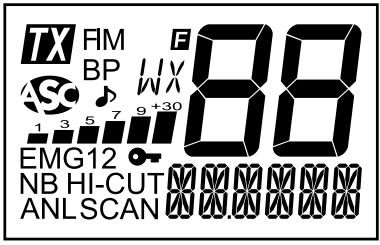
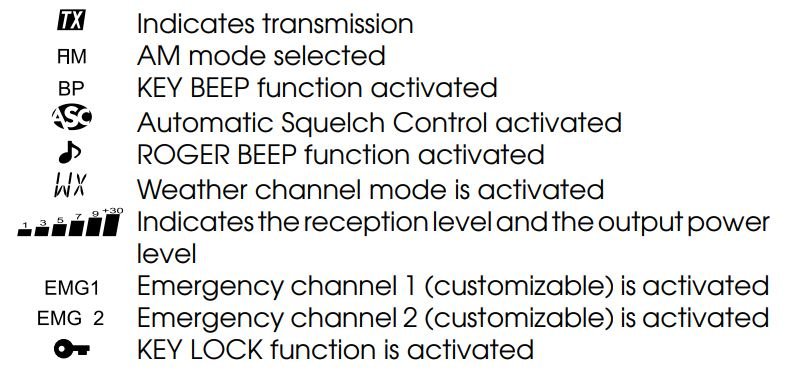

5) ROGER BEEP ~ KEY LOCK
ROGER BEEP (short press)
The ROGER BEEP sounds when the PTT switch (11) of the microphone is released in order to let your correspondent speak. Historically as CB is a “simplex” communication mode, it is not possible to speak and listen at the same time (as it is the case with a telephone). “Once the conversation was over, “Roger” was said in order to indicate “received” or “message understood”. The word “Roger” has been replaced by a significant beep. That is where the words “Roger beep” comes from.”
Press the ROGER (5) key to activate/deactivate the ROGER BEEP function.
When the function is activated, “BP ” appears on the display.
KEY LOCK (long press)
Press and hold the ![]() key (5) to lock then unit. “
key (5) to lock then unit. “ ![]() ” appears on the display. Press and hold the
” appears on the display. Press and hold the ![]() key (5) again to unlock then unit. “
key (5) again to unlock then unit. “ ![]() ” disappears from then display.
” disappears from then display.
Note: The PTT switch (11) remains enable while the unit is locked.
6) ANL/NB ~ HI-CUT
ANL/NB (short press)
A short press on the ANL/NB key (6) allows you to alternate between the following settings: no filter / ANL activated / ANL and NB activated.
The icon of the active filter appears on the display.
HI-CUT (long press)
A long press on the HI-CUT key (6) activates/deactivates the HI-CUT filter. When the filter is activated “HI-CUT” appears on the display.
HI-CUT: Cuts out the high frequency interferences and has to be used in accordance with the reception conditions. When active, the filter is displayed on display.
7) CB/WEATHER CHANNEL ~ ALERT
CB/WEATHER CHANNEL (WX) (short press)
CB functions are not allowed in WX mode. If user presses a not allowed key and KEY BEEP function is activated, the radio sounds error tone.
Press the CB/WX key (7) to alternate between CB and WX mode. When WX mode is activated, “ WX ” appears on the display.
The WX mode allows to hear weather information. When the mode is activated, use the 🔼/🔽 keys (3) on the unit or the UP/DN keys on the microphone to move through the 7 weather channels to find the active channel in your local area (see WEATHER FRENQUENCY TABLE page 59). The display shows the selected weather channel and if the unit receives a signal, “ WX ” and “ A ” icons blink.
ALERT (long press)
The SIREN tone only sounds in CB mode. It does not sound in WX mode. Long press the ALERT key (7), in order to activate/deactivate the ALERT function. When the function is activated and a tone is detected at the selected weather channel, then the unit sounds SIREN tone. The unit cancel CB mode and go to WX mode. During a SIREN tone sound, press PTT key (11) to stop the sound.
8) EMG ~ EMG SETTING
EMG (short press)
Emergency channel is automatically selected when by pressing EMG Key (8). First short press to call the first emergency customisable channel (or the default channel 9). “EMG1” appears on the display. Second short press to call the second emergency customisable channel (or the default channel 19). “EMG 2” appears on the display. Third short press to go back to the current channel. “EMG…” disappears on the display.
EMG SETTING (long press)
Priority channels can be assigned to any channel. To define a new priority channel:
- Press shortly the EMG key (B8) to select the priority channel to be customized. “EMG1” or “EMG 2” should be displayed on the LCD.
- Press the EMG key (8) for one second to set the selected channel. EMG-ST is displayed. “EMG1” or “EMG 2” blinks.
- Use 🔼/🔽 key (3) on the unit or UP/DN key (3) on the microphone to select the new channel to assign to the priority channel selected at the point 1.
- Press shortly the EMG key (8)briefly to confirm your choice. The unit returns to CB mode.
- If no key is pressed for 10 seconds, the unit automatically exits the setting function to return to CB mode. The default priority channels are channel 9 (EMG1) and channel 19 (EMG2) respectively.
9) USB CHARGING SOCKET
The USB socket (9) can be used to charge a smartphone, tablet or other rechargeable device with 5 V – 2.1 A.
10)6 PIN MICROPHONE PLUG
The plug is located on the front panel of the transceiver and makes the setting of the equipment into the dashboard easier. The BILL FCC accepts electret or dynamic microphone (see menu MIC TYPE on page 12). See cabling diagram page 60.
11)PTT (Push To Talk)
Transmission key, press PTT switch to transmit a message,![]() is displayed and release to listen to an incoming communication.
is displayed and release to listen to an incoming communication.
TOT (Time Out Timer)
If the PTT switch (11) key is pressed for more than 3 minutes, the display starts blinking and the transmission ends. A beep will sound until the PTT switch (11) key is released.
FUNCTIONS TURNING ON THE UNIT
Three additional functions are available. KEY BEEP, COLOR and MIC TYPE.
To activate a function, first turn off the unit. Then turn on the radio while pressing the corresponding key (5, 7 or 5 + 6).
1) KEY BEEP (key 5)
Some operations such as changing channels, pressure on keys etc. are confirmed by a beep tone. This function can be activated or deactivated as follows:
- Turn off the power and then turn on the power while holding down the ROGER key (5). KEY BP appears in the display. The state of the function alternates between On and Of.
- The unit automatically exits the function to return to CB mode after 3 seconds. When the function is activated, “ BP ” is displayed.
2) COLOR (key 7)
- Turn off the power and then turn on the power while holding down the CB/WX key (7). COLOR appears in the display.
- The current color symbol flashes RE(red), GR(green), BL(blue), CY(cyan), YE(yellow), PU(purple), or LI(light blue).
- Use 🔼/🔽 key (3) on the unit or UP/DN key (3) on the microphone to change the color.

- Press the PTT switch (11) to confirm and exit.
- If no key is pressed for 10 seconds, the unit automatically exits the function to return to CB mode.
3) MIC TYPE (keys 5 + 6)
The BILL FCC accepts 6-pin PRESIDENT electret or dynamic microphone. In order to alternate between the two types :
- Turn off the power and then turn on the power while holding down bot ROGER key (5) and ANL/NB key (6). MIC-TP appears in the display. The state of the function alternates between electret EL and dynamic dY.
- The unit automatically exits the function to return to CB mode after 3 seconds.
Note: On power up, in order to inform the user, the programmed microphone type is displayed for 2 seconds (see § ON/OFF page 8).
A) DC-POWER TERMINAL (13,8 V)
B) ANTENNA CONNECTOR (SO-239)
C) EXTERNAL SPEAKER JACK (8 Ω, Ø 3,5 mm)
TECHNICAL CHARACTERISTICS
1) GENERAL
– Channels : 40
– Modulation mode : AM
– Frequency ranges : from 26.965 MHz to 27.405 MHz
– Weather channels : 162,400 MHz to 162,550 MHz
– Antenna impedance : 50 ohms
– Power supply : 13.8 V
– Dimensions inches : 4.02 (W) x 3.94 (D) x 0.98 (H)
millimeters : 102 (W) x 100 (D) x 25 (H)
– Weight : ± 0.705 lbs / ± 0.320 kg
– Accessories supplied : Electret microphone with support, mounting cradle, quick fixation clip, screws.
2) TRANSMISSION
– Frequency allowance : +/- 200 Hz
– Carrier power : 4 W
– Transmission interference : inferior to 4 nW (- 54 dBm)
– Audio response : 300 Hz to 3 KHz
– Emitted power in the adj. channel : inferior to 20 µW
– Microphone sensitivity : 5.5 mV (elec.) / 2.2 mV (dyn.)
– Maximum drain : 1.7 A
– Modul. signal distortion : 2 %
3) RECEPTION
– Maxi. sensitivity at 20 dB sinad : 0.5 µV – 113 dBm
– Frequency response : 300 Hz to 3 kHz
– Adjacent chan. selectivity : 60 dB
– Maximum audio power : 2.5 W
– Squelch sensitivity : minimum 0.2 µV – 120 dBm maximum 1 mV – 47 dBm
– Frequency image rejection rate : 60 dB
– Intermediate frequency rejection rate : 70 dB
– Drain : 180 ~ 500 mA
TROUBLE SHOOTING
1) YOUR CB RADIO WILL NOT TRANSMIT OR YOUR TRANSMISSION IS OF POOR QUALITY
– Check that the antenna is correctly connected and that the SWR is properly adjusted.
– Check that the microphone is properly plugged in.
2) YOUR CB RADIO WILL NOT RECEIVE OR RECEPTION IS POOR
– Check that the squelch level is properly adjusted.
– Check that the volume is set to a comfortable listening level.
– Check that the microphone is properly plugged in.
– Check that the antenna is correctly connected and that the SWR is properly adjusted.
3) YOUR CB WILL NOT LIGHT UP
– Check the power supply.
– Check the connection wiring.
– Check the fuse.
HOW TO TRANSMIT OR RECEIVE A MESSAGE
Now that you have read the manual, make sure that your CB Radio is ready for use (i.e. check that your antenna is connected).
Press the «push-to-talk» PTT switch (11) and announce your message «Attention stations, transmission testing» which will allow you to check the clearness and the power of your signal. Release the switch and wait for a reply. You should receive a reply like, «Strong and clear».
If you use a calling channel (19) and you have established communication with someone, it is common practice to choose another available channel so as not to block the calling channel.
GLOSSARY
Below you will find some of the most frequently used CB radio expressions. Remember this is meant for fun and that you are by no means obliged to use them. In an emergency, you should be as clear as possible.
INTERNATIONAL PHONETIC ALPHABET
A Alpha H Hotel O Oscar V Victor
B Bravo I India P Papa W Whiskey
C Charlie J Juliett Q Quebec X X-ray
D Delta K Kilo R Romeo Y Yankee
E Echo L Lima S Sierra Z Zulu
F Foxtrott M Mike T Tango
G Golf N November U Uniform
TECHNICAL VOCABULARY
AM : Amplitude Modulation
CB : Citizen’s Band
CH : Channel
CW : Continuous Wave
DX : Long Distance Liaison
DW : Dual Watch
FM : Frequency Modulation
GMT : Greenwich Meantime
HF : High Frequency
LF : Low Frequency
LSB : Lower Side Band
RX : Receiver
SSB : Single Side Band
SWR : Standing Wave Ratio
SWL : Short Wave Listening
SW : Short Wave
TX : CB Transceiver
UHF : Ultra High Frequency
USB : Upper Side Band
VHF : Very High Frequency
CB LANGUAGE
Advertising : Flashing lights of police car
Back off : Slow down
Basement : Channel 1
Base station : A CB set in fixed location
Bear : Policeman
Bear bite : Speeding fine
Bear cage : Police station
Big slab : Motorway
Big 10-4 : Absolutely
Bleeding : Signal from an adjacent channel interfering with the transmission
Blocking the channel : Pressing the PTT switch without talking
Blue boys : Police
Break : Used to ask permission to join a conversation
Breaker : A CBer wishing to join a channel
Clean and green : Clear of police
Cleaner channel : Channel with less interference
Coming in loud and proud : Good reception
Doughnut : Tyre
Down and gone : Turning CB off
Down one : Go to a lower channel
Do you copy? : Understand?
DX : Long distance
Eighty eights : Love and kisses
Eye ball : CBers meeting together
Good buddy : Fellow CBer
Hammer : Accelerator
Handle : CBer’s nickname
Harvey wall banger : Dangerous driver
How am I hitting you? : How are you receiving me?
Keying the mike : Pressing the PTT switch without talking
Kojac with a kodak : Police radar
Land line : Telephone
Lunch box : CB set
Man with a gun : Police radar
Mayday : SOS
Meat wagon : Ambulance
Midnight shopper : Thief
Modulation : Conversation
Negative copy : No reply
Over your shoulder : Right behind you
Part your hair : Behave yourself – police ahead
Pull your hammer back : Slow down
Rat race : Congested traffic
Rubberbander : New CBer
Sail boat fuel : Wind
Smokey dozing : Parked police car
Smokey with a camera : Police radar
Spaghetti bowl : Interchange
Stinger : Antenna
Turkey : Dumb CBer
Up one : Go up one channel
Wall to wall : All over/everywhere
What am I putting to you? : Please give me an S-meter reading
GENERAL WARRANTY CONDITIONS
This device is guaranteed 2 years parts and labour in its country of purchase against any manufacturing defects validated by our technical department. PRESIDENT After Sales Service department reserves the right not to apply the warranty in the event a breakdown is caused by an antenna other than those distributed by PRESIDENT. An extension of 3 years warranty is proposed systematically for the simultaneous purchase of a device and a PRESIDENT antenna, bringing the total duration of the warranty to 5 years. In order to be valid, the warranty registration must be completed and submitted within a period of 30 days after the purchase date to PRESIDENT ELECTRONICS online at www.president-electronics.us/warranty-registration. You can also access this warranty registration page by using your smartphone to read (application must be available) the QR code. You will receive a confirmation email if the registration is successfully completed. Please keep a copy of this email for your records.
Any repair under warranty will be without charge and the return delivery costs will be borne by PRESIDENT. A proof of purchase sales receipt must be included with the device to be repaired. The dates listed on the warranty registration and proof of purchase must match. In case the device is not under warranty, the repair and return of the device will be charged.
No spare parts will be sent nor exchanged by PRESIDENT under warranty. Do not proceed with the installation of the device without reading the user manual. The warranty is only valid in the country of purchase.
Exclusions (not covered by Warranty):
- Damages caused by accident, shock or inadequate packaging.
- Power transistors, microphones, lights, fuses and the disrespect of the installation and use of specifications (including but not limited to antenna used with too high power, final output power transistors (SWR), inversion of polarities, bad connections, over voltage…).
- The warranty cannot be extended due to the non-availability of the device while it is being serviced at PRESIDENT After Sales Service department, nor by a change of one or more components or spare parts.
- Transceivers which have been modified. The warranty application is excluded in case of modification or poor maintenance done by a third party not approved by PRESIDENT ELECTRONICS.
If you note a malfunction:
- Check the power supply of your device and the quality of the fuse.
- Check that the antenna, the microphone are correctly connected.
- Check that the squelch level is properly adjusted; the programmed configuration is the correct one.
- In the event of a real malfunction, please contact your dealer first. He will decide what action should be taken.
In case of an intervention not covered by warranty, an estimate will be established before any repair.
Thank you for your confidence in the PRESIDENT quality and experience. We recommend that you read this manual carefully so that you are completely satisfied with your purchase.

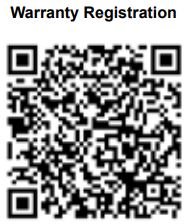
CHANNEL FREQUENCY TABLE
| Channel | Frequency | Channel | Frequency |
| 1 | 26,965 MHz | 21 | 27,215 MHz |
| 2 | 26,975 MHz | 22 | 27,225 MHz |
| 3 | 26,985 MHz | 23 | 27,255 MHz |
| 4 | 27,005 MHz | 24 | 27,235 MHz |
| 5 | 27,015 MHz | 25 | 27,245 MHz |
| 6 | 27,025 MHz | 26 | 27,265 MHz |
| 7 | 27,035 MHz | 27 | 27,275 MHz |
| 8 | 27,055 MHz | 28 | 27,285 MHz |
| 9 | 27,065 MHz | 29 | 27,295 MHz |
| 10 | 27,075 MHz | 30 | 27,305 MHz |
| 11 | 27,085 MHz | 31 | 27,315 MHz |
| 12 | 27,105 MHz | 32 | 27,325 MHz |
| 13 | 27,115 MHz | 33 | 27,335 MHz |
| 14 | 27,125 MHz | 34 | 27,345 MHz |
| 15 | 27,135 MHz | 35 | 27,355 MHz |
| 16 | 27,155 MHz | 36 | 27,365 MHz |
| 17 | 27,165 MHz | 37 | 27,375 MHz |
| 18 | 27,175 MHz | 38 | 27,385 MHz |
| 19 | 27,185 MHz | 39 | 27,395 MHz |
| 20 | 27,205 MHz | 40 | 27,405 MHz |
WEATHER FREQUENCY TABLE
| Channel | Frequency |
| 1 | 162,550 MHz |
| 2 | 162,400 MHz |
| 3 | 162,475 MHz |
| 4 | 162,425 MHz |
| 5 | 162,450 MHz |
| 6 | 162,500 MHz |
| 7 | 162,525 MHz |
6-PIN MICROPHONE PLUG
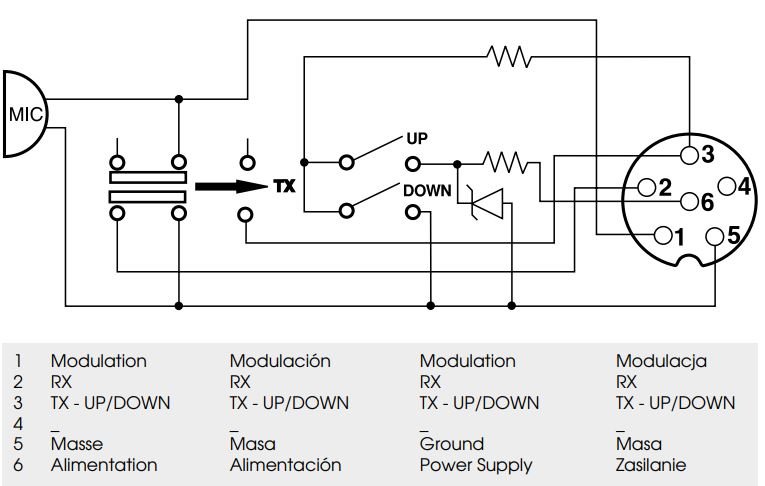
IC RSS-GEN, Sec 7.1.2 Warning Statement – (Required for Transmitters)
Under Industry Canada regulations, this radio transmitter may only operate using an antenna of a type and maximum (or lesser) gain approved for the transmitter by Industry Canada. To reduce potential radio interference to other users, the antenna type and its gain should be so chosen that the equivalent isotropically radiated power (e.i.r.p.) is not more than that necessary for successful communication.
IC RSS-GEN, Sec 7.1.2 Warning Statement – (Required for Transmitters w/ detachable antennas)
This radio transmitter has been approved by Industry Canada to operate with the antenna types listed below with the maximum permissible gain and required antenna impedance for each antenna type indicated. Antenna types not included in this list, having a gain greater than the maximum gain indicated for that type, are strictly prohibited for use with this device.
RF Exposure Warning Statements
The antenna used for this radio must be properly installed and maintained and must provide a separation distance of at least 53 cm (21 Inches) from all persons and must not be collocated or operated in conjunction with any other antenna or transmitter. Never transmit if any person is closer than the specified distance to the antenna. Note that PRESIDENT does not specify or supply any antenna with this transceiver. While a 0 dBi gain antenna is normal for a typical installation, the above limit applies to any antenna with up to 3 dBi gain.
IC RSS-GEN, Sec 8.4 / RSP-100, Sec 8.4
This device complies with Industry Canada’s license-exempt RSSs. Operation is subject to the following two conditions: (1) This device may not cause interference; and (2) This device must accept any interference, including interference that may cause undesired operation of the device.


HEAD OFFICE/SIÈGE SOCIAL: USA – 1007 Collier Center Way, Naples, Florida 34110
Web: http://www.president-electronics.us • Phone: +1 239.302.3100
Email: [email protected]
Download Manual PDF
President TXUS001 BILL FCC ASC
User Manual PDF Download
